Garden
11 Types of Pothos You Can Easily Grow Indoors
There are many easy plant options to grow indoors.
Low-light succulents such as Echeverias and Jade plant.
Or plants like Dumb Cane and Peace Lily.
But it wouldn’t hurt a bit if there were more of these kinds of plants, right?
Pothos is one such breed. It is arguably the easiest houseplant that even a novice gardener can grow.
And to get you excited, there are several types of Pothos to choose from.
Below are 11 of them. (Types of Pothos)
Variegated Pothos types
We mention this Pothos variety first because it is the most abundant subspecies. (Types of Pothos)
1. Manjula Pothos
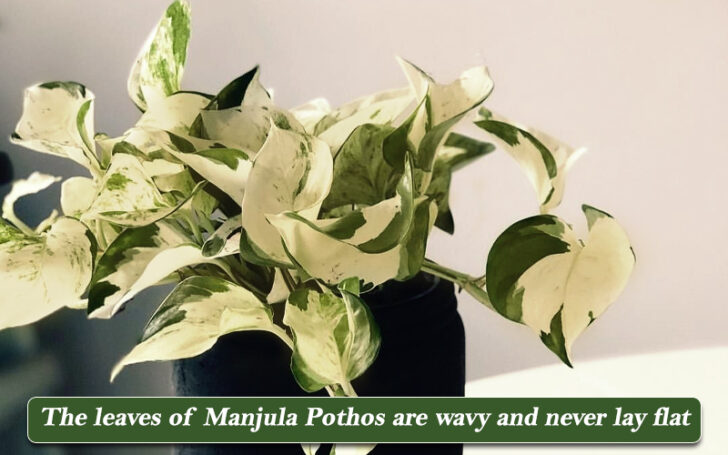
This patented variety was produced by the University of Florida.
Leaves: It has heart-shaped leaves with wavy edges that never stay straight. Marked with gold and cream spots, each leaf will be different from the next, and if we’re completely honest with you, it will be extremely pleasing to the eye. (Types of Pothos)
Some leaves will be green with white spots around the edges, while others will be creamy white with green spots; every new leaf is a mystery in itself (Enjoy every new growth 😊).
Size: Manjula Pothos is not a fast grower. It grows no more than 1-2 feet tall and spreads to the same length.
Sunlight: Bright, indirect light is best. If you keep it in direct sunlight, the coloration will decrease and you will get greener leaves.
In addition, white and cream spots are more likely to be scorched by sunlight. (Types of Pothos)
Pro tip: If you notice brown spots on the leaves, immediately move the plant to a location with less light.
Water requirement: It likes moist soil but not wet. Water when the top layer of soil is completely dry. Reduce the frequency of watering during the winter months. (Types of Pothos)
Soil: We did a lot of research and found a very suitable soil mix for you: 50% potting mix, 25% perlite and 25% cactus mix.
Composition may vary in results depending on the weather conditions of the state in which you live. Prepare the mixture on a garden mat.
Growth rate: Grows slowly due to variety. Its white and cream color means it lacks chlorophyll, which ultimately means less food for growth. (Types of Pothos)
2. Marble Queen Pothos
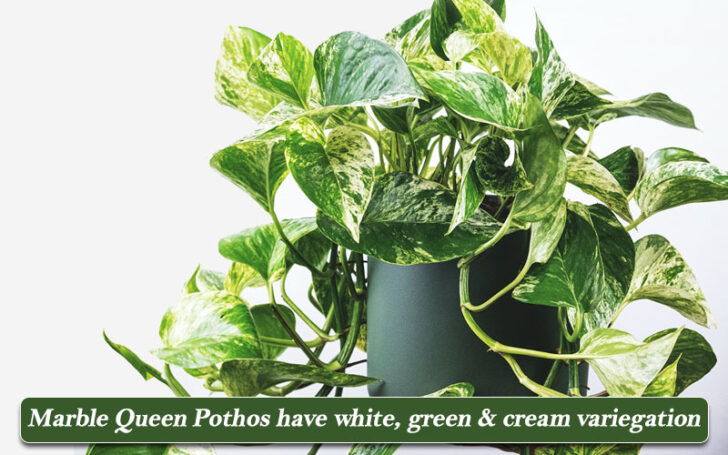
Much like Manjula Pothos, this green-and-white beauty artistically brightens the corners of your room or office. (Types of Pothos)
Leaves: The leaves are heart-shaped and dark green mottled with patches of white or silver. The edges can be wavy or straight.
People often confuse this and Manjula Pothos herb, but there are distinct differences.
Manjula Pothos has golden, cream, and green variegated leaves, while Marble Queen Pothos has green, cream, and white variegated leaves. (Types of Pothos)
Also, the patches are quite dispersed in Manjula, but there is more mottling in the case of the Marble Queen.
Size: The Marble Queen Pothos can be expected to grow up to 3 meters, albeit slowly. It likes to spread out or go down and can spread a lot if not pruned.
Sunlight: Can tolerate shade, but prefers medium to bright indirect sunlight. Like Manjula Pothos, the leaves will turn green if not given proper light. (Types of Pothos)
The leaves will burn if kept in direct sunlight, so avoid doing this.
Water requirement: Water when the top layer of soil dries up in summer and spring. During the Winter, however, wait for the entire soil to dry first.
For this, wait until you see the leaves drooping slightly and then water it. (Types of Pothos)
Soil: Add a well-drained and aerated soil mix for healthy growth. If you notice a problem with the drainage of the soil, add some sand mix.
A wonderful composition is an equal mix of peat moss, perlite and soil mixture.
Growth rate: Grows faster than Manjula Pothos. It is also an herb and you can grow them in pots or hanging baskets.
Make sure to prune the tall vines every few months to keep the plant bushy. (Types of Pothos)
3. Golden Pothos
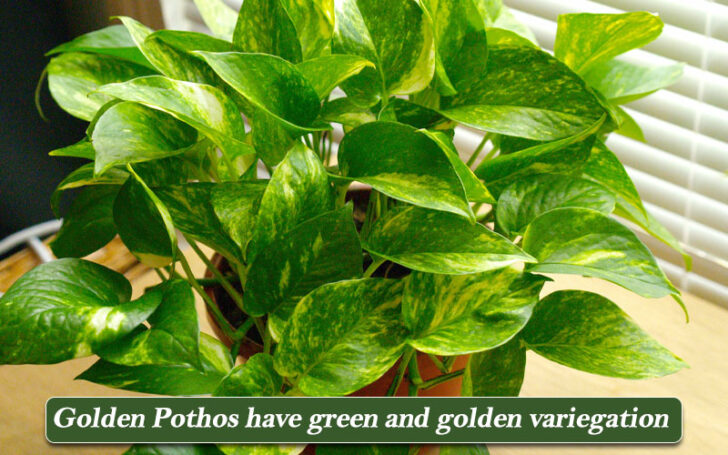
It is the most common type of Pothos and probably the easiest to care for. You can find this trailing variety in abundance at nurseries or online. (Types of Pothos)
Leaves: Golden Pothos is characterized by heart-shaped green leaves that are irregularly spotted all over with golden markings. The degree of coloration depends on sunlight.
The greater the light intensity, the more pronounced the variegation will be.
Size: Young plants grow to 6 inches high but are a fast growing variety and can grow to 10 feet if not pruned. (Types of Pothos)
You can start from a small pot and hide it after the pot looks overcrowded.
Sunlight: Prefers bright, indirect light.
Water requirement: Water when the top 2 inches of soil are dry. Usually water every 1-2 weeks.
Growth rate: How fast do Golden Pothos plants grow? Depends on weather and light intensity.
It grows very slowly if kept indoors in the shade. Speed increases if kept indoors in bright, indirect light or grown outdoors in a shaded location.
It grows even faster when attached to a pole or any support. (Types of Pothos)
4. Jessenia Pothos
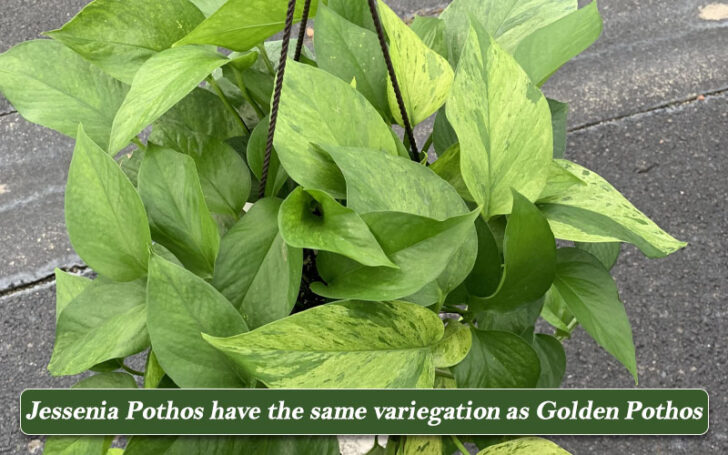
This trailing vine is hardy enough to grow in varying conditions. It is very similar to the Golden Pothos. We prefer to pair it with white-green Pothos for a lively effect. (Types of Pothos)
Jessenia Pothos can be considered the rarest Pothos. You won’t find it as easily as Golden Pothos.
Leaves: The leaves are green with shades of gold and yellow inside. Sometimes in the form of thin, river-like lines, sometimes in the form of speckles or large dots.
Size: It can grow up to 10 feet tall indoors, according to Plantcaretoday. (Types of Pothos)
Sunlight: Like other Pothos, it grows best in bright, indirect light. However, it does not stop growing in shady or dark corners of your home, so if you have a dark room, you are in luck with this plant.
Water requirement: Water after 8-14 days. The good thing is that you won’t be upset if you forget to follow this water cycle. (Types of Pothos)
Soil: Nothing special. Normal well-drained soil will do just fine.
Growth rate: Grows slower than Golden Pothos, faster than Marble Queen and Manjula Pothos. You can play with the humidity and light intensity levels to increase the growth rate. (Types of Pothos)
Loves a moist environment if you want to accelerate growth.
5. Pearls and Jade Pothos
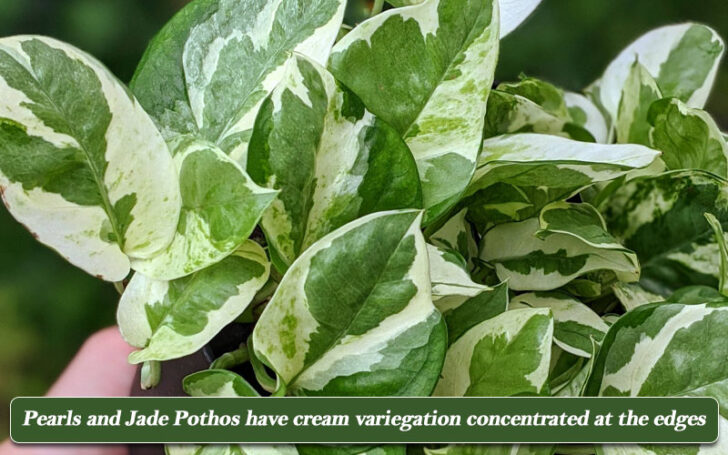
This is a spore variant of Marble Queen and is often confused with NJoy Pothos. We will discuss the difference below. (Types of Pothos)
Leaves: It has gray-green leaves with concentrated cream or silver-gray variegated stripes on the margins.
They are smaller than common Pothos leaves and are mottled with green spots in the cream-white region.
Size: Grows to 2-5 feet in spread and 6-8 inches in height. Because it is a trailing variety, if you consider growing it in hanging baskets, it will grow to 6-10 feet.
Another great houseplant is Peperomia Prostrata.
Sunlight: Bright indirect sunlight. (Types of Pothos)
Water requirement: They need water after 1-2 weeks. Do not overwater as it will cause root rot. Since it is of tropical heritage, misting it with a water gun occasionally will also help.
Soil: Well-drained and well-aerated soil with a pH of 6-7.
Growth rate: Grows slower than other Pothos. You’d only get a few inches in months. (Types of Pothos)
6. N Joy Pothos
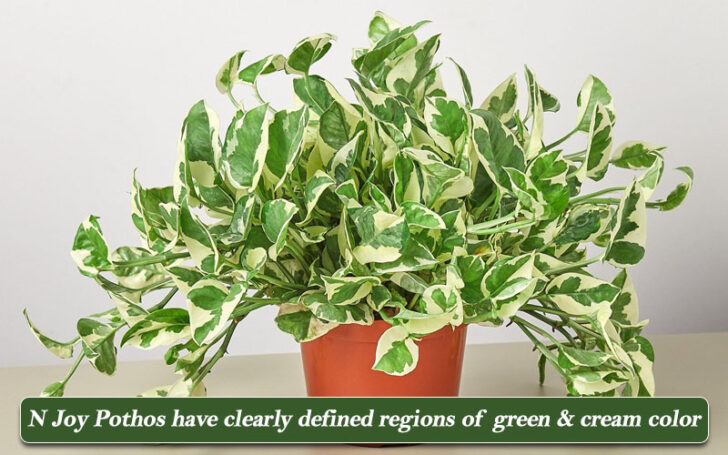
N Joy Pothos is a close relative of Pearls and Jade Pothos.
Leaves: It has heart-shaped cream and green leaves. (Types of Pothos)
What is the difference between N Joy, Pearls and Jade Pothos leaves?
N Joy leaves are open, no dots on them. The leaves of Pearls and Jade Pothos are mottled with green spots, while the cream and green zones are defined by clear edges.
Size: It can reach 10 meters in length. If we talk about height, it will be 9 inches maximum.
Sunshine: Same as Pearls and Jade Pothos.
Water needs: Water when the top 1-2 inches of soil is dry.
Soil: Equal parts of peat and perlite.
Growth rate: It grows fast and can become leggy if not pruned in time. Also, if your plant is leggy, place it in a location that gets a good amount of indirect light. (Types of Pothos)
7. Glacier Pothos
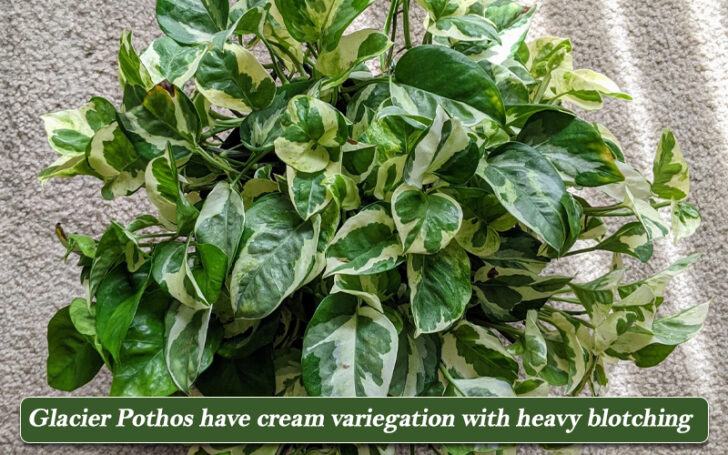
Glacier Pothos is another trailing variety mixed with N Joy and Pearls and Jade Pothos. The biggest difference is that Glacier Pothos has more spots than the other two. (Types of Pothos)
Leaves: Small leaves are dark or green with cream colored patches.
Size: Grows up to 20 inches.
Sunlight: Bright and indirect light is best.
Water requirement: Water requirement is not different from other Pothos. Water once a week in the summer and every two weeks in the winter.
If the leaves are curling, water them immediately. It is an indication that the plant needs water.
Soil: Good quality organic potting soil based on peat. (Types of Pothos)
Growth rate: Not defined.
8. Satin Pothos
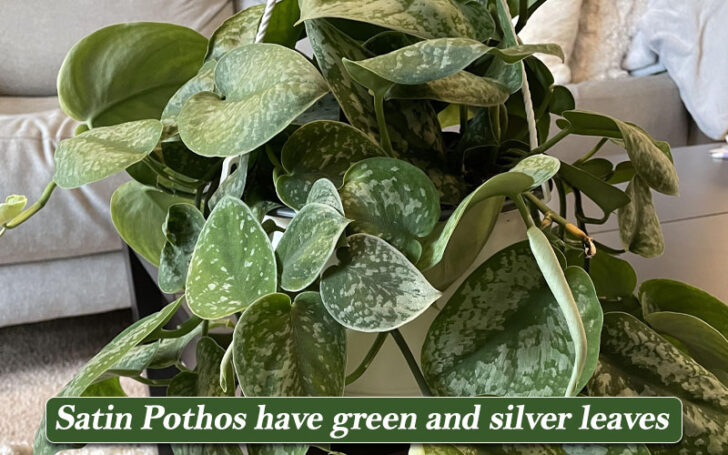
Satin Pothos or Scindapsus Pictus is a vine with miraculous green and silver leaves.
Leaves: It has large arrow-shaped leaves with dark green and silver markings. Sometimes the silver markings suppress the green colors and other times they make it green.
Size: About 3 feet.
Sunlight: Place near a sun-facing window, otherwise small leaves will start to grow.
Water requirement: Once a week is sufficient. If the leaves are curling, it means it needs water.
Soil: A mixture of equal parts soil mix and perlite. If you water less, make the composition 60% earth and 40% perlite.
Growth rate: Grows slowly to moderately, but bright indirect light can accelerate the growth process. Adding a 20-10-10 fertilizer is another catalyst for growth.
Non-variegated Pothos varieties
Variegation is quite common in Pothos, but there are still some non-variegated cultivars.
Let’s diversify your vision with them.
9. Neon Pothos
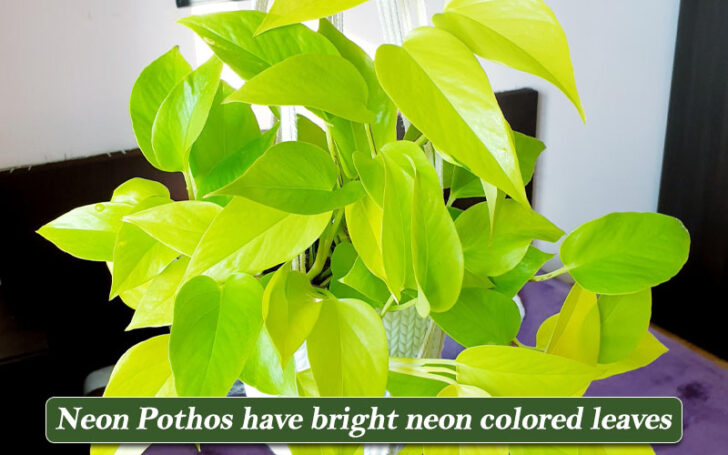
Known for its bright, neon-colored leaves, Neon Pothos is also very easy to care for.
Leaves: Heart shaped and bright neon color. People are instantly drawn to this sheen on the leaves but be careful, the color can turn dark and dull if not kept in bright light.
Size: It grows to about 2-3 feet, but can also reach 6-7 feet if you let it hang from pots. They are ideal for decorating office and room corners.
Sunlight: Low light dulls the leaves, while prolonged exposure to sunlight causes the leaves to wilt. Balance is very important here.
They can also grow in the bathroom, but the color and presentation that people miss in this plant can only be achieved when placed near a window that receives 4-5 hours of light a day.
Water requirement: Water once a week. Do not over-fertilize as it will kill Neon Pothos.
Soil: Organic potting soil containing peat moss or coconut peat.
Growth rate: They are normal and fast growers when optimum conditions are provided. High humidity or low light will reduce plant growth rate.
10. Jade Pothos

We have included Jade Pothos in this category because of its very low degree of coloration, although it is slightly varied. It is a new variety and rare to find.
Leaves: It has waxy green leaves that become darker as they mature. The veins of the leaves are clearly visible to the naked eye.
Size: Usually no more than 1 foot.
Sunlight: Requires medium to low, indirect light.
Water requirement: Once a week in Summer and Spring. Twice a week in Autumn and Winter.
Soil: Top with a handful of well-drained potting mix with perlite to increase soil drainage.
11. Cebu Blue Pothos
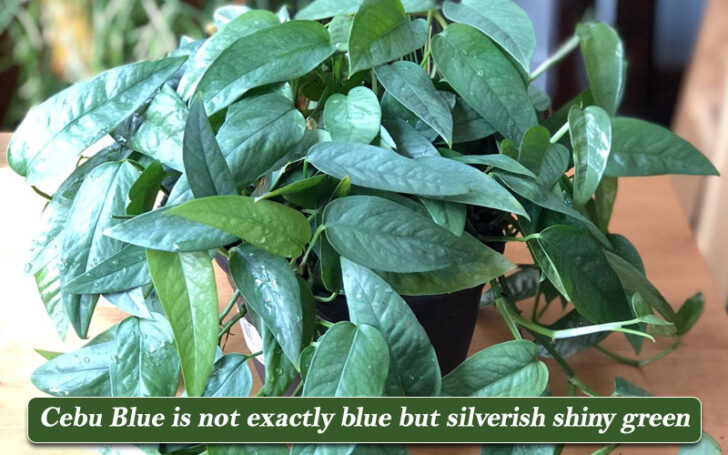
Cebu Blue isn’t exactly blue, it’s a silvery bright green.
Leaves: Arrow-shaped or oval leaves have a silver-blue hue at a young age. The silver color fades as it matures.
Size: Anywhere between 1-4 feet. If you let them follow a basket, they can grow to a more substantial height.
Sunlight: They grow best in bright, indirect light. They should not be kept in direct bright light as it will burn the leaves.
Water needs: Water a little more often than other types of Pothos. They like a moist environment, so consider placing them in a tray of water filled with gravel.
Or use a good moisturizer.
Soil: Regular potting mix with a touch of orchid bark is good for this plant.
Growth rate: They are not fast growers like Golden Pothos.
Bottom line
That’s it for the Pothos varieties. Keep visiting our Gardening articles on the Inspire Molooco Blog for more helpful information.